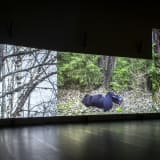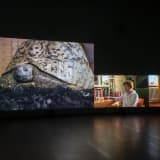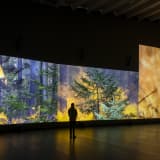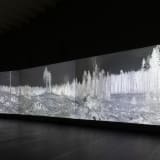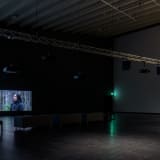Eija-Liisa Ahtila - Reflection of a Forest Serlachius
EIJA-LIISA AHTILA REFLECTION OF A FOREST
2025 | 50 min | 60 min loop | 8 x 4K UHD 16:9 | Audio 8.0 | 8–channel projected installation with changing number of projections.
The number and size of projected images will vary to reflect the theme of each scene and the material contained in it
Original languages: English, Chinese, Finnish and Swedish with English and Finnish subtitles.
© Crystal Eye – Kristallisilmä Oy / Produced by Ilppo Pohjola
SYNOPSIS
CONTEXT
The focus of my practice since the mid-2000s has been to disengage moving image art from anthropocentrism and to achieve a corresponding shift in expression. In my multi-channel installations I have searched for ways in which the language of the moving image might be used to create a relevant depiction of realities in this age of climate warming, overconsumption and mass extinction.
This approach has enabled me to ask interconnected questions about the ecological moving image, such as, can a tree be the protagonist of a story (Horizontal, 2011); how is representation affected by the aspect ratio of the film camera, and what things cannot be depicted with a low, horizontal rectangular film frame (The Annunciation, 2010); or how do the traditional rules of film editing produce familiar narrative structures that are nevertheless unsuited to depicting non-human species (Anthropocentric Exercises on Film, 2011). The question that arises from such considerations is how the technology and instruments of the moving image might be adapted to narration in which information can only be captured by realigning that very same technology.
Such considerations led me to create a work in the form of a lecture-performance (Studies on the Ecology of Drama, 2014). Its aim was, and is, to draw attention directly to the building blocks of cinematic narrative, such as the manipulation of time and space, the role and means of the performer, and the construction of visual information. This is achieved in the work through the use of analogies and the exposition of different modes of perception. The purpose of highlighting these devices and methods of moving image depiction is to establish an intelligible and reasoned starting point for change.
REFLECTION OF A FOREST
Whereas Studies on the Ecology of Drama presented relevant questions concerning the construction of an ecological narrative, Reflection of a Forest applies the means of creating a moving image work in a manner that supports the shift from anthropocentrism to a more diverse experience of our co-existence.
STARTING POINT
The essential concept in the construction of the work is the spatiality of being – how life exists in a shared space sustained by the diversity of its inhabitants. This notion of the nature of life leads to the question, how to present such a reality – how to create other kinds of images of our habitats that would nevertheless be recognizable to us. The initial starting point for the work was a forest, because of its living reality, mutuality of being inside the forest, as well as below in the soil and above it in the air.
As the work progressed, however, the idea of possible locations expanded. For instance, we shot footage in an apple orchard that had been overtaken by the surrounding forest, and we created combinations of indoor and outdoor spaces for various scenes.
METHOD
In order to construct different images and viewpoints, the location – this living entity that is to be filmed – needs to be approached differently. To put anthropocentrism aside, to forget the idea and the hierarchy of a centre and its surroundings, one needs a different kind of working method that enables the objective.
The traditional procedure of first scripting, then shooting and editing was simply unsuitable for achieving that purpose. It needed to be replaced with collaboration with the location: starting with visits to the place to observe, learn about the space, shoot footage, edit short episodes to grasp the options, then write the script based on notes from these earlier forays, and finally shoot on location again.
I also made a visual script of the collected material on the wall of my studio to enable me to remember the myriad of things related to each milieu and to see and recognize the possible dramaturgy between the elements of the work.
CHARACTER
When the starting point is to abandon anthropocentrism, one of the first questions that emerges is, who or what can be a performer or a protagonist? Obviously, the notion of acting, too, needed to be adjusted to fit the context – to be shifted towards the idea of performing and showing.
The performers in Reflection of a Forest include a forest, a black tree, an older woman, a young Chinese man, a local farmer, a breathing oak, brown soil, blackbirds, beavers, a group of insects dancing, Daubenton’s bats, red-necked grebes, a lake, an old turtle...
DIALOGUE
There is talk and words in the scenes. All texts are called dialogues even when there is only one person speaking. The purpose of this is to refer to communication and the dialogues that exist in the locations between the performers in the piece. The performers that speak are not exclusively human. The line between speaking aloud and using voice-over to refer to internal speech, such as an animal thinking or speaking, or a tree engaging in a dialogue with a human, is deliberately unclear/ambiguous. The dialogues are written like poems.
INSTALLATION
The work is presented as an installation consisting of multiple projections. The images are projected on a wall. The purpose is to keep the exhibition space and structures present in the viewing situation.
There are altogether eight projections: three small and three large horizontal projections as well as two vertical ones. The number of images projected simultaneously vary from one to five to reflect the theme of each scene and the material contained in it. This is achieved with a shutter in the projector.
Some of the scenes, such as landscapes, involve three projectors creating together a single, wide image. Human performers are placed in the smaller horizontal projections. Others, such as the scene with tiny flies dancing in the air lit from the back by the setting sun, starts with a single projection in the middle. The scene then gradually opens up as other projections join in, to finally form a view of the location.





